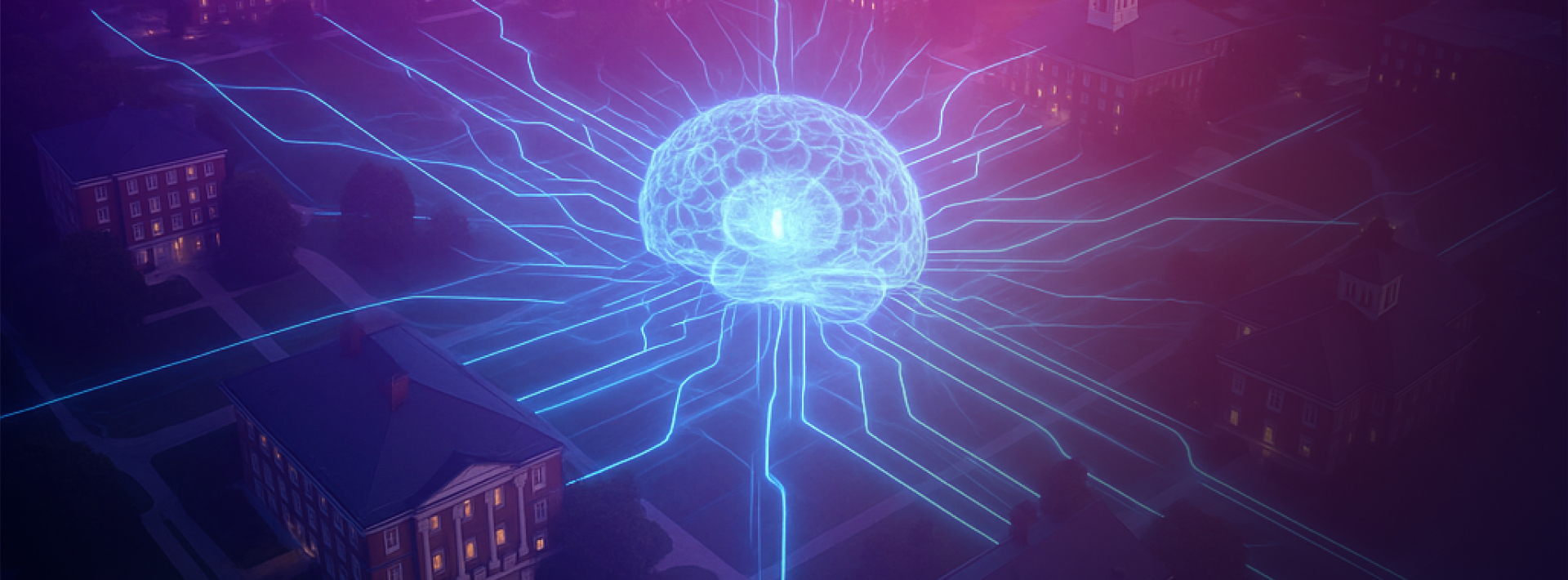Part 3 of our series Rewired: The New AI Architecture of Higher Education
Part 1: The New AI Architecture of Higher Education | Part 2: How Higher Education Proves Value in the Skills Economy
You can have the perfect enrollment strategy. You can deliver credentials that employers both trust and understand. But none of it matters if your systems frustrate students at every turn.
The State of Higher Education 2025 highlights how AI is already transforming administrative operations. Institutions are cutting admissions decision times from weeks to days. That efficiency gain matters, but it’s pointing at something bigger. The most transformative applications of AI in higher education will happen in the invisible systems that touch students every day and determine whether institutions can actually deliver on their promises of personalized pathways, skills verification, and career outcomes.
The Invisible Systems that Determine Everything
Think about what student-facing infrastructure should look like: registration that anticipates scheduling conflicts before they derail a semester, financial aid that explains packages in plain language and flags missing steps in real time, advising that surfaces degree progress at midnight without requiring an appointment, and career services that connect learning to opportunity throughout the educational journey rather than just senior year.
Now consider what most students actually experience. Most universities operate on infrastructure built before students expected real-time information, before mobile-first design, and before APIs enabled systems to communicate seamlessly. Advising platforms can’t access degree audit tools. Financial aid offices require documentation already submitted during admissions because systems don’t share data. Registration workflows assume students know course prerequisites that aren’t clearly mapped anywhere accessible.
This friction is the difference between serving traditional students adequately and serving diverse learners well. A 19-year-old living on campus might tolerate process-heavy systems because they have time to navigate them. A 35-year-old parent working full-time while taking evening classes cannot.
When Systems Don’t Talk
Here’s what disconnected systems look like in practice: A student registers for next semester’s courses. The registration system confirms enrollment, but the degree audit tool doesn’t update for 48 hours. The student panics, thinking they’ve registered wrong, and emails their advisor, who also can’t see the registration because their advising platform pulls data overnight. By the time systems sync, the student has already spent hours searching for answers that should have been instantly available.
Or consider the transfer student navigating data silos. Transcript evaluation sits in one system. The academic advisor works in another. The degree audit reflects only current-institution courses. Financial aid can’t see transfer credits until manually entered elsewhere. Each office operates with partial information, and the student becomes the integration layer, having to shuttle information between departments, resubmit documentation, and try to piece together what no system can provide.
These challenges define daily operations for institutions managing disconnected systems, and they’re a key reason students choose to leave. Academic quality and affordability still matter, but experience now defines whether education feels achievable or exhausting.
Building Systems that Create Advantage
Better experiences lead to stronger retention, which enables sustained enrollment, which funds continued improvement, which attracts students who see a responsive institution. This cycle creates compounding advantages.
As the State of Higher Education 2025 report notes, students want “an integrated and seamless experience on campus like they have with Amazon 1-Click, Netflix preferences, and Instagram likes.” The goal is not consumerization, but rather alignment with the baseline expectations of how digital systems should function in 2025.
The institutions that invest in operational intelligence now will differentiate themselves in ways competitors can’t quickly replicate. Competitors can replicate program offerings, but integrated systems that learn from student behavior and adapt over time create advantages that take years to build.
From Disconnected Systems to Institutional Data Intelligence
The challenge institutions face goes beyond isolated student-facing systems. It’s a fundamental question about how data flows across the entire institution and whether that data can inform better decision-making at every level.
The EDUCAUSE 2025 Horizon Report: Data and Analytics Edition identifies the shift “toward unified data models and integrated data ecosystems” as critical for institutional effectiveness. The report notes significant barriers remain: “slow adoption of common data standards, lack of in-house expertise, tight budgets, and concerns about privacy and security when connecting different data sources.”
But institutions that overcome these barriers will build systems that “respond more quickly, spot and support at-risk students earlier, and evaluate programs more effectively as a whole.” This is what infrastructure modernization actually means: not just upgrading individual systems, but creating the connective tissue that enables institutional learning.
Imagine infrastructure that functions like a learning organism. Student outcomes from last semester inform course scheduling for next semester. Advising patterns surface which interventions work for specific populations. Registration data reveals course conflicts before hundreds encounter them. Each cycle generates insights that make the next more effective.
The EDUCAUSE report warns that “rapid AI adoption is introducing new risks” but is equally clear about the path forward: institutions must “develop clear policies and build cross-functional governance structures that include voices from IT, academic affairs, compliance, and student services.” This is the work of infrastructure modernization: integrating intelligence across systems while maintaining human oversight, transparency, and accountability.
The Infrastructure Challenge for Lifelong Learners
Traditional systems assume continuous enrollment, students who enter as freshmen and graduate four years later. These assumptions are embedded in everything from registration workflows to student information systems to advising models.
Serving lifelong learners requires fundamentally different infrastructure. Systems need to remember students across years of non-enrollment. Credential systems must stack learning experiences accumulated across time and institutions. Registration workflows need to accommodate students taking one course while working full-time.
The platform approach outlined in the first article in this series now defines the path forward for institutions ready to scale lifelong learning. Without unified infrastructure, institutions will continue to relegate adult learners to separate systems that feel like second-class experiences. The institutions that build infrastructure for lifelong learning will turn the enrollment cliff and broader demographic changes into drivers of innovation and competitive advantage.
The Infrastructure Behind Skills-Based Credentials
The second article of our series outlined the opportunity in skills-based credentials. But credential transformation depends entirely on infrastructure most institutions don’t yet have. Making educational outcomes relevant to employers requires systems that track competency development across courses and verify skill demonstration through assessed work. These systems must translate learning outcomes into employer language and enable dynamic credential pathways as employment demands evolve.
Right now, course outcomes exist in syllabi. Assessment data sits in learning management systems. Career outcomes are tracked separately. None of these systems talk to each other, and none can generate the comprehensive, verifiable credentials students need. Building this infrastructure requires more than technical expertise. It depends on registrars, academic affairs, career services, IT, and institutional research working from unified data models.
Where to Start
Transformation gains traction through precise, coordinated initiatives that evolve into integrated systems over time.
Start with a data integration pilot in one high-friction area, such as transfer credit evaluation, financial aid processing, or advising workflows. Build the connections that eliminate manual handoffs. Use that pilot to establish governance patterns and technical standards that can scale.
Map the student journey to identify friction points. Follow students through registration, financial aid, advising, and enrollment. Document every place they encounter disconnected information or redundant data entry. These pain points become your integration roadmap.
Most importantly, build with student-facing impact in mind. Every integration should make something tangibly better, such as faster information, clearer guidance, reduced manual work, or more responsive service. Infrastructure projects that deliver only backend efficiencies will struggle to sustain commitment. Projects that demonstrably improve student experiences will build momentum for continued transformation.
The Infrastructure Imperative
This series has outlined a clear progression: who to serve (lifelong learners at all career stages), how to prove value (skills-based credentials and AI-powered career connection), and what makes it possible (operational infrastructure that executes strategy at scale).
The institutions that lead will approach transformation as an interconnected system. Success with diverse learners comes from modern infrastructure, and lasting credential innovation emerges from systems built to verify skills throughout learners’ lives.
Infrastructure serves as a core differentiator, converting strategic vision into operational strength. It’s the difference between institutions that adapt to demographic change and those that watch enrollment decline while running on systems built for students who no longer represent their future.
The work is demanding. It requires sustained commitment, cross-functional collaboration, and investment in capabilities that many institutions have historically under-resourced. Continuing to operate on disconnected systems while competitors advance with unified platforms limits growth and long-term resilience.
Transformation begins with the essential work of modernizing systems, integrating data, and building platforms that serve lifelong learners. That’s where real differentiation happens, and that’s what determines institutional success in the decade ahead.
The pace of AI change can feel relentless with tools, processes, and practices evolving almost weekly. We help organizations navigate this landscape with clarity, balancing experimentation with governance, and turning AI’s potential into practical, measurable outcomes. If you’re looking to explore how AI can work inside your organization—not just in theory, but in practice—we’d love to be a partner in that journey. Request an AI briefing.
Key Takeaways
- Infrastructure Determines Experience.
Student success depends on how seamlessly systems deliver that quality. Unified data ecosystems transform friction into retention.
- Operational Intelligence Creates Competitive Advantage.
Integrated systems generate insights that compound, improving services, reducing friction, and enabling faster, more confident decisions across every department.
- Data Modernization Fuels Skills Transformation.
Skills-based credentials thrive when infrastructure connects learning outcomes, assessment data, and career results across institutional silos.
- Lifelong Learning Requires Lifelong Systems.
Serving returning adults, career changers, and continuous learners calls for infrastructure designed for flexibility, persistence, and re-entry across time.
- Transformation Begins with Integration.
The most successful modernization efforts start small, targeting one high-friction process, and expand through clear governance, shared standards, and visible student impact.
FAQs
Why does infrastructure modernization matter for student success?
Modern systems remove friction in core experiences such as registration, advising, and financial aid. When data flows seamlessly, students receive faster responses, clearer guidance, and more personalized support.
What does operational intelligence mean for higher education?
Operational intelligence describes systems that automate processes and learn from them. When institutions integrate data across departments, they gain the ability to anticipate student needs, identify risks earlier, and continuously improve operations.
How does infrastructure connect to skills-based credentials?
Skills-based learning depends on interoperable data. Institutions need infrastructure that connects course outcomes, assessments, and verified competencies, creating credentials that employers understand and trust.
Where should institutions start with modernization?
Start with a pilot that addresses a visible student challenge such as transfer credit evaluation or financial aid delays. Use that project to establish governance patterns, integration standards, and measurable improvements that demonstrate value across the institution.
What defines a future-ready institution?
A future-ready institution treats infrastructure as a living system that learns and adapts. It measures success by student outcomes, institutional agility, and the ability to serve learners continuously throughout their careers.
Like the article? Share with friends:














